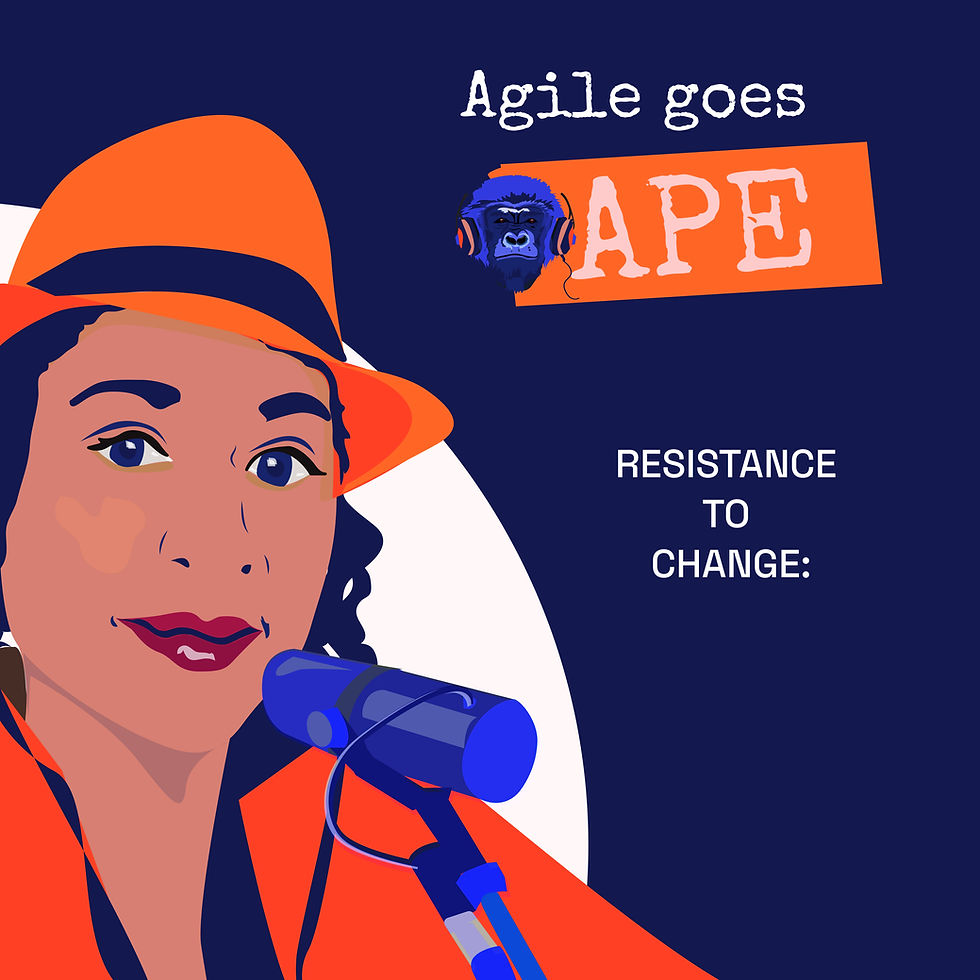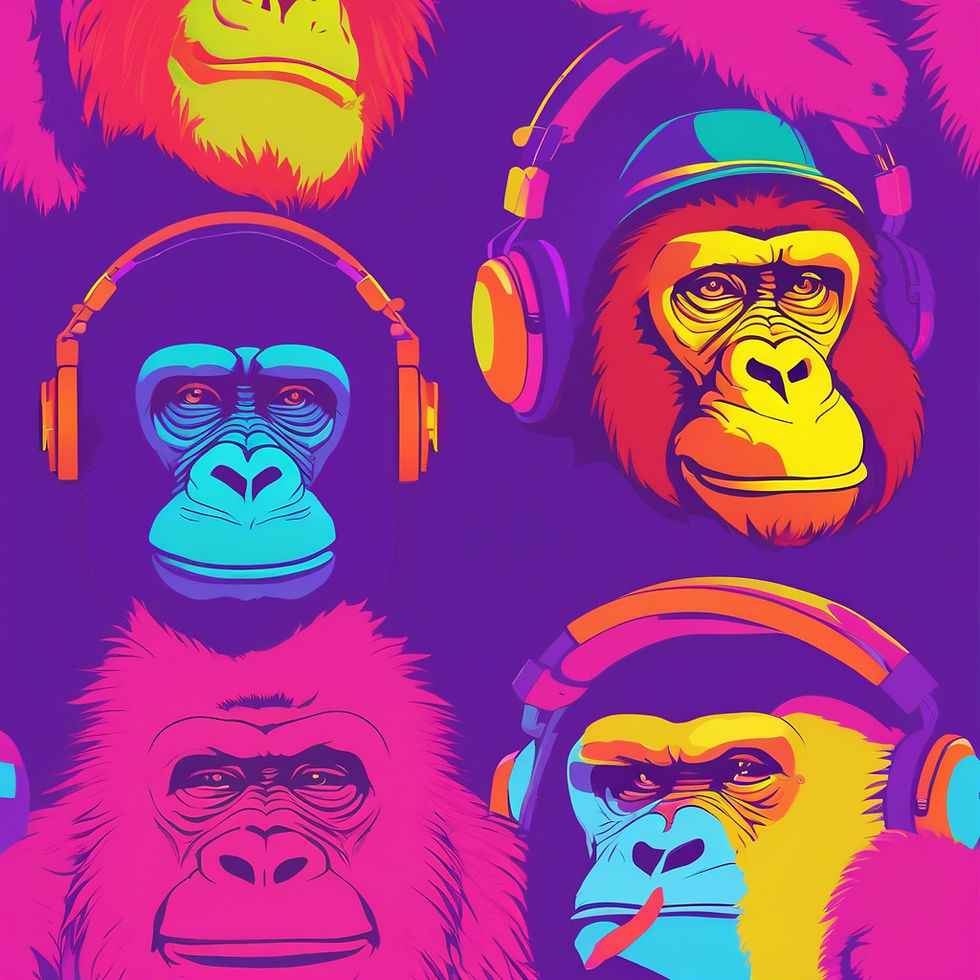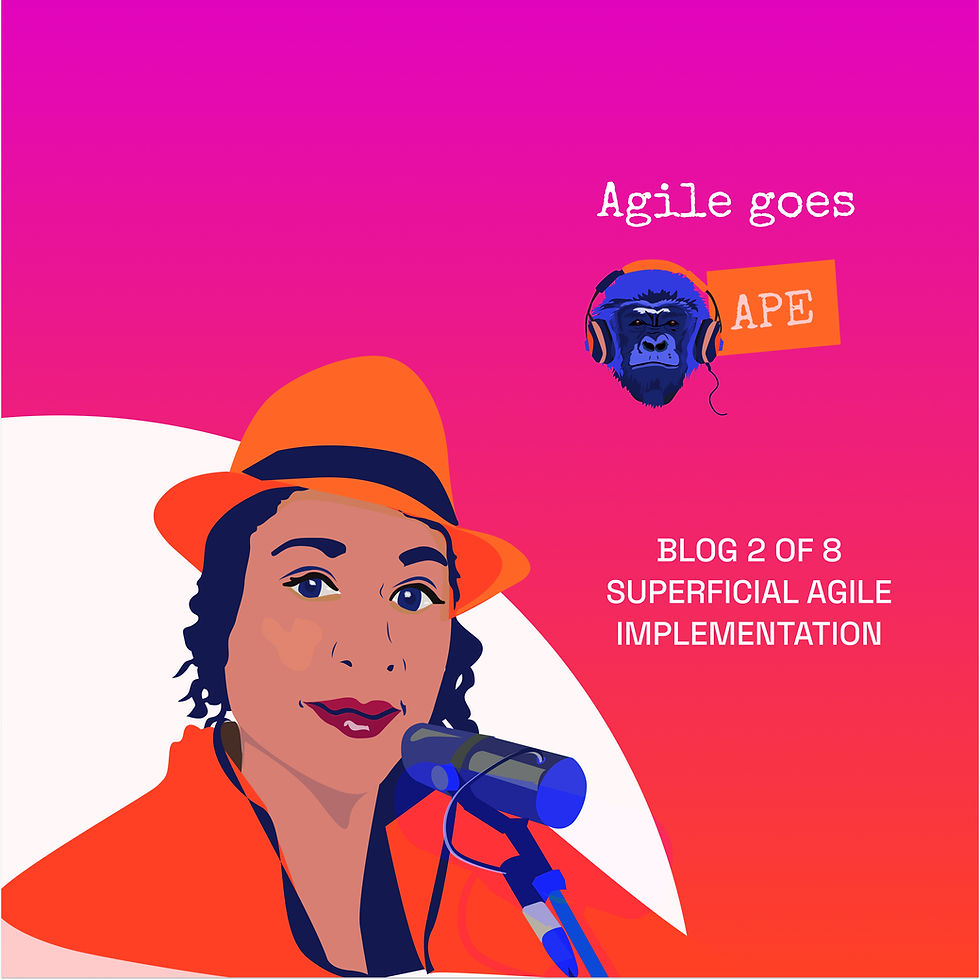Blog 1 of 8: Resistance to Change: The Cultural and Mindset Maze
- Attia Jamil

- Jun 24
- 13 min read
Updated: Jul 4

Welcome to the first of eight bananas in our Agile Goes Ape blog bunch!
This blog might wear an Agile name tag, but make no mistake our heartbeat is delivery. Consistent, valuable, sustainable delivery. Agile isn’t the goal; delivery is. Agile just happens to be one of the best ways to get there, when done with care, clarity, and a bit of courage.
In this blog, you'll find:
Why culture and mindset are at the heart of change resistance
Three core psychological reasons teams resist change (with theory and Agile Peel Tips)
Practical tips to move from resistance to resilience
Four juicy case studies from our consulting jungle
Lessons learned from the field, inspired by Lencioni and real transformation work
A chance to join our podcast or have a cheeky coffee chat with us
This is the first blog in a new series where we dive deep into real Agile delivery challenges with a splash of psychology and a lot of cheek. We first teased these themes in our LinkedIn launch post here. Each blog will zoom in on one core challenge, and this one tackles the big one: resistance to change.
Let’s be honest: change is a bit like Marmite. Some folks love it. Most eye it suspiciously, sniff it, poke it, and decide it’s best left on the shelf. Especially in the entertainment world, where passion and creativity rule, trying to change the way things have always been done can feel like asking Shakespeare to write a TikTok script.
It’s also a bit like the cheese in Who Moved My Cheese? when the familiar disappears, most people freeze, panic, or stubbornly wait for things to return to normal. But those who sniff out change and scurry ahead often find the new cheese faster. Unlike the mice, we can choose to lead change with clarity, conversation, and a healthy dose of curiosity.
But why is it so hard? At the heart of resistance to change lies culture and mindset. Let’s define those bananas before we slip on them: Culture is the shared set of values, norms, and unwritten rules that shape how work gets done it’s the vibe, the rituals, the inside jokes. Mindset, on the other hand, is how individuals perceive and respond to their environment. It's the personal lens shaped by experience, belief, and bias. Culture is the unspoken rulebook of how we do things around here. Mindset is the lens through which individuals view that rulebook. When change knocks, it doesn’t just challenge tasks and timelines it pokes at identity, threatens comfort zones, and rattles the social fabric.
The Banana Skins of Resistance And How to Peel Them
Fear of the Unknown: When teams can’t see the other side of the change, they stick to the familiar. As Berger and Calabrese (1975) explain in their Uncertainty Reduction Theory, humans are motivated to reduce ambiguity in their environment.
Peel Tip: Run a Futurespective workshop to help the team visualise the world post-change.
Loss of Control: Change often feels like it’s being done to people, not with them. According to Deci and Ryan's Self-Determination Theory, autonomy is a fundamental human need, and lack of it diminishes motivation.
Peel Tip: Create shared ownership through working agreements and team charters.
Misaligned Values: If the change doesn’t resonate with what the team believes in, it gets quietly resisted. This ties into Festinger's Cognitive Dissonance Theory, which suggests that people avoid inconsistencies between their beliefs and new information or behaviour.
Peel Tip: Use a Cultural Web or Agile Fluency diagnostic to surface tensions between beliefs and behaviour.
Culture Eats Change for Breakfast
You can have the slickest change plan this side of Soho, but if it clashes with your team’s values, it’ll flop. That’s why leaders must tune in to the cultural rhythm before introducing anything new. Agile ways of working, for example, thrive on trust, transparency, and collaboration values that must be cultivated long before your first stand-up meeting.
Let’s bring this to life with an example: A creative studio known for high-concept ads struggled when shifting from ad-hoc creative bursts to sprints. Daily stand-ups felt like time theft, backlogs were dismissed as bureaucratic, and user stories got re-written as punchlines. The fix? We reframed rituals in creative language stand-ups became “morning spark sessions,” backlogs turned into “idea vaults,” and user stories evolved into “audience adventures.” When the culture felt seen, Agile found its seat at the table.
Cultural Trait vs Agile Value Table
Culture Trait | Agile Conflict | Remedy |
Avoid conflict | Limits feedback | Foster safety in retros |
Hero culture | Discourages collaboration | Promote team-based recognition |
Hierarchical | Blocks autonomy | Empower cross-functional squads |
Perfectionism | Delays delivery | Embrace iterative experimentation |
From Resistance to Resilience
The golden ticket? Make change feel less like an interruption and more like an invitation. Here’s how:
We call it The Four S’s of Resilient Change:
Story: Humans connect through narratives. Share the why behind the change. What problem are we solving? What dream are we chasing?
Stage: Involve people early. Co-create the change. Give them a role and they’ll champion it.
Small Wins: Change doesn’t need fireworks every week, but even a small win deserves applause. Highlight momentum.
Safety: Let teams know it’s okay to feel unsure. Safe spaces for feedback and reflection help people lean in instead of opting out.
Real-World Resistance and Real-World Remedies
In every organisation where change has stuck, especially in Product and Engineering (PETS), success starts with empathy, observation, and data. We don't just watch we immerse. That means observing the team and their wider ecosystem, conducting 1:1s with individuals, and reviewing the practices and processes in place at both the company and team level. We pay special attention to how they measure predictable delivery and quality. This depth of discovery is then captured in a structured analysis document, a clear, evidence-based narrative of what's working, what's not, and where the bottlenecks lie.
Importantly, our approach isn’t just about the data. It’s also about building human connection. The conversations we have, the trust we build, and the behaviour we observe in the wild all shape our understanding. Human behaviour often tells a story that data alone can’t tone, body language, interactions, hesitation. These qualitative insights are just as critical as metrics when diagnosing what’s really going on beneath the surface. From that foundation, we build a practical playbook to prioritise interventions and catalyse progress.
The examples below are pulled from real-life scenarios where our analysis identified root causes and accelerated change. In some cases, the fixes were fast and effective. In others, transition took longer but progress was made, measured against agreed benchmark data points and metrics.
Case Study 1: Bottlenecked Discovery
One company transitioning from heavy governance to Agile struggled with an elongated discovery phase. This caused market delays and idle engineering. Analysis revealed key roles (BA and Architect) were mismatched. One disengaged, the other under-delivering due to personal ties with leadership. The fix: constructive dialogue and role transitions. But the deeper issue was trust and lack of performance transparency. We addressed these with hiring practice reviews, anonymous feedback channels, and clearer escalation paths.
But how do we break this anti-pattern? We exposed it using data and tangible evidence. This wasn’t a simplistic tale of heroes and villains. Yes, the individuals involved were disengaged or possibly taking advantage of a broken system, but the root cause sat elsewhere. There were no robust hiring practices, no effective performance mechanisms, and no safe or visible paths for escalating feedback. The disengaged individual wasn’t actively managed, and their dissatisfaction was a symptom of broader systemic neglect. Meanwhile, the under-performer stayed unchecked because their manager looked the other way and no one held that manager accountable.
You can stick a plaster on it, but if you don’t fix the underlying fractures, the same pattern will repeat often with new faces and even greater impact. That’s when good actors burn out or bail. People are more open to change than we give them credit for especially when you deal with operational realities transparently and with integrity. But don’t overlook the toll on the team. When strong team members constantly have to compensate for underperformance or disengagement, they carry an unfair weight. Over time, that leads to burnout or resignation. No one wins in that scenario. Fixing systemic issues isn't just about improving outcomes; it's about retaining the people who care enough to make a difference. Especially when you deal with operational realities transparently and with integrity.
Case Study 2: Unpredictable Delivery
Three product teams (iOS, Android, Web) lacked alignment. Roadmap volatility undermined delivery predictability. Using Team Topologies, we restructured teams, aligned backlogs, and improved designer-engineer collaboration. Features released across platforms simultaneously, communication improved, and downstream teams like Marketing and CS could plan reliably.
However, it wasn’t just the operating model. The skillset of the product function was a major factor. Gaps in product management capability meant decisions lacked rigour, prioritisation was reactive, and user outcomes weren’t clearly articulated. By up-skilling product leads and redefining product ownership roles, we bolstered delivery maturity and strategic clarity.
Practically, we merged the teams into a unified squad, agreed on shared definitions of 'Ready' and 'Done', and reconfigured our use of Jira to work for us rather than against us. We also adapted our ceremonies to better fit the new structure and introduced dedicated team bonding time. This cultural cohesion, paired with a refreshed delivery model, helped the team move from scattered to synchronised. From there, we continued to introspect and improve building momentum through monthly retrospectives, refining ways of working, and celebrating progress as a team. There was a lot that went on under the hood and we're always happy to discuss it in greater detail. Feel free to reach out if you're curious how these approaches might translate to your context.
Case Study 3: KPI Stagnation
A promoted data analyst turned Product Owner lacked training, leading to aimless delivery. On the surface, the team viewed this person as a superstar dependable, engaged, and visibly busy. But under the hood, the delivery impact was murky. There was no clear link between features and KPIs, and progress had stalled. The designer aligned too closely with the PO, going native, which blurred boundaries and reduced critical thinking in delivery decisions.
So how did we break through? We used data. We asked: has this feature undergone RICE or a similar prioritisation mechanism to justify customer and business value? Who is the target audience? What KPI is this meant to shift? Does leadership even understand what this feature is for? We gathered feedback from individuals outside the team, reviewed historical performance, and mapped this against the skillset needs for a mature product role.
This gave us the confidence to have an honest, respectful conversation with the individual. We explored their goals and clarified expectations and in some cases, like this one, it’s not always a training issue. Sometimes you run into misalignment or even bad actors. In those scenarios, the data becomes your ally. Let it tell the story so you can focus on solutions, not speculation. And let’s be honest managers also need to take accountability. How did this person go from data analyst to Product Owner with no formal assessment or training? The root problem doesn’t lie solely with the individual. It’s a systemic oversight, and part of leadership’s role is ensuring people are set up for success, not thrown into the deep end without a paddle. We can only identify the root cause and propose solutions in this case, leadership took too long to act. That delay allowed the problems to persist, and the company failed to achieve the outcomes it needed. As soon as the underperformance was addressed and the bad actor was removed, openness to change increased and people saw the benefits. But let’s be honest it’s rarely comfortable. This is where leadership must make tough decisions for the greater good. And sometimes, leadership inadvertently advocates for chaos by not taking the necessary action when it counts.
The fix? Training, accountability, and a strategic cascade:
company strategy → departmental KPIs → team metrics. This realigned output with outcomes and lifted team morale.
Case Study 4: Quality Concerns in QA
QA was blamed for production bugs. The real issue: no shift-left mindset, minimal user story detail, and siloed delivery. We tackled this with coaching on user stories, BDD practices, and improved stakeholder communication. Quality became a shared responsibility, not a QA scapegoat.
We reshuffled the process to embed QA upstream, ensuring they were involved from the earliest stages of planning. Then, we reviewed all processes and practices to promote a shift-left mentality that actually worked for the company's context and the personalities within it. We strengthened the QA function by collaborating on a clear QA strategy one that valued development input and aligned with the broader delivery goals. We also embedded the principle of "you build it, you fix it" to eliminate the old throw-it-over-the-fence culture.
Finally, we introduced the right level of reporting to surface patterns around production bugs and made it transparent who contributed to the fix. This fostered shared accountability and helped build a genuine culture of quality ownership.
We also boosted automation coverage from 20% to 95%. This significantly increased confidence in the release process and was paired with a sustainable QA maintenance plan. We also connected the QA team with the Customer Support (CS) team to regularly review the top five customer issues. This helped us determine whether a bug was technical or a UX issue, and we fed that insight into the product process. It not only helped us identify production bugs earlier but also contributed to happier customers, improved CSAT, and boosted NPS scores. We made QA everyone’s business by inviting the whole team to participate in exploratory testing. Automation is brilliant but at the end of the day, it’s a script. Exploratory testing uncovers edge cases and user paths we might not have predicted. That combination gave us super confidence in quality assurance. We also introduced an AI tool called Enterpret, which linked into Zendesk and other data sources to compile cross-functional dashboards. This enabled QA, Product, and CS teams to jointly evaluate and prioritise the most impactful customer and business-facing bugs. It not only strengthened collaboration but also sparked discussions on optimisation opportunities helping teams determine which features to introduce or retire based on insight, not assumption. Getting there took time, nearly two years as the company had other higher-priority pressures. So, we chipped away at it whenever possible and continuously included it as a roadmap candidate. To strengthen our case, we used data to demonstrate that the lack of automation was contributing to delays. Quantifying the cost of inaction helped convince business stakeholders.
At the end of the day, the time it takes to fix an issue depends on how quickly leadership wants to move on it. If a company acknowledges something is a problem and genuinely wants to solve it, they must invest even if it’s hard when priorities compete. It's always a juggling act, but the long-term benefits of early and consistent investment in quality are undeniable.
Before we swing into lessons learned, let’s tie it all together. These case studies are more than war stories they’re the vines we’ve used to map real resistance and real results. Each one spotlights where culture, mindset, and delivery intersect, revealing patterns that help teams move forward with clarity and confidence.
Jungle Wisdom: Lessons from the Field
Looking across the case studies, several key patterns emerged:
Misaligned roles and lack of clarity consistently stall progress.
Data-driven conversations can cut through perception bias and surface root causes.
Leadership delay in taking action is often more damaging than the original issue.
When accountability becomes shared and transparent, momentum builds.
Quality thrives not in silos but through integration, feedback loops, and team-wide ownership.
We place strong emphasis on delivery not just output, but predictable, sustainable delivery. And delivery isn’t a single switch; it’s a recipe made of several key ingredients: trust, transparency, collaboration, empowered teams, clear goals, and just enough structure to keep momentum without killing creativity.
And let’s not forget the foundational dynamics of how teams tick (or don’t). Patrick Lencioni’s Five Dysfunctions of a Team is especially relevant here, resistance often stems not from process or tools, but from deeper interpersonal fractures:
Absence of Trust: When team members don’t feel safe being vulnerable, they won’t voice concerns or ideas.
Fear of Conflict: Avoiding tough conversations leads to fake harmony and unspoken resistance.
Lack of Commitment: Without clarity or buy-in, teams drift, and change initiatives lose traction.
Avoidance of Accountability: When no one calls out poor performance, dysfunction flourishes.
Inattention to Results: Personal agendas override team goals, making it harder to align with strategic change.
These dysfunctions often echo in the stories we hear during transformations and Agile, when done right, can provide the rituals and relationships that heal them.
Start with the business goals and desired culture.
Observe and listen without assumptions.
Let data reveal the true narrative.
Use proven Agile tools like value stream mapping, story mapping, and user research.
Focus on people as much as process.
Stage Tags for Application:
Early Discovery: Observe and diagnose culture, establish psychological safety.
During Transformation: Co-create rituals, align metrics, foster feedback.
Post-Implementation: Reflect, refine, reinforce mindset alignment.
A Final Encore
To make change real and sustainable, it takes everyone. Buy-in and adoption need to come from both leadership and the foot soldiers on the ground. If you only have one, it won’t stick. You also need someone to provide guidance and support to bring it all together and champion the process. And just as important, have advocates ready to pass the baton and keep the momentum going.
In the end, resistance isn’t the enemy. It’s a sign your culture is paying attention. Your job as a change maker is not to bulldoze over that resistance, but to dance with it. Bring curiosity, compassion, and a bit of cheeky charm to the stage, and you might just find that your greatest blockers become your most passionate believers.
Because when culture and mindset align with purpose and possibility, that’s when the real magic happens.
Question for You: Where have you seen resistance turn into resilience in your teams?
Each case study in this blog could easily be a blog of its own. If you’ve got questions about how we made significant change happen or want to explore how this applies to your context connect with me. I'm always happy to chat in person if you're in London or over a video call anywhere else.
If you'd like to share your story, join our podcast guest list we're chatting with real people tackling real Agile messiness. Or fancy a coffee chat instead? Drop me a line always happy to monkey around with a flat white and a good tale.
Subscribe to get the next banana in your inbox 🍌 You can sign up for podcast guest updates or book a virtual coffee on our site . New blogs drop every two weeks, so keep your eyes peeled!
References:
Johnson, S. (1998). Who Moved My Cheese? An Amazing Way to Deal with Change in Your Work and in Your Life. G.P. Putnam's Sons.
Rose, C. (2021). Testing in DevOps: A Shift Left Approach to Quality and Performance. IT Revolution Press.
Lencioni, P. (2002). The Five Dysfunctions of a Team: A Leadership Fable. Jossey-Bass.
Patton, J. (2014). User Story Mapping: Discover the Whole Story, Build the Right Product. O'Reilly Media.
Rother, M., & Shook, J. (2003). Learning to See: Value Stream Mapping to Add Value and Eliminate MUDA. Lean Enterprise Institute.
Berger, C.R., & Calabrese, R.J. (1975). "Some explorations in initial interaction and beyond: Toward a developmental theory of interpersonal communication." Human Communication Research.
Deci, E.L., & Ryan, R.M. (1985). Intrinsic motivation and self-determination in human behavior. Springer.
Festinger, L. (1957). A Theory of Cognitive Dissonance. Stanford University Press.










Comments